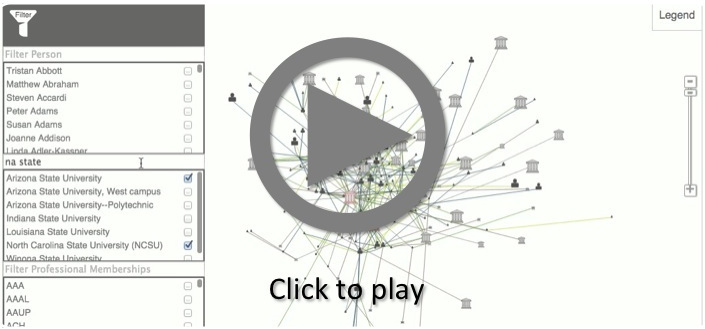Future Directions
The Writing Studies Tree (WST) provides an alternate way of conceptualizing the field in which we work, research, and teach. In other words, it can provide new perspectives on something that, because we are immersed in it, can become too close to see. Additionally, it serves as an example of the benefits (and challenges) of merging the methods and tools of both academic genealogy and digital / data-driven scholarship.
But the WST’s contribution is more than just as a tool to capture relationship data. Ramsay and Rockwell (2012) encouraged us to “think of digital artifacts as theories […, i.e.] as hermeneutical instruments through which we can interpret other phenomena. Digital artifacts like tools could then be considered as ‘telescopes for the mind’ that show us something in a new light” (para. 11). As we discussed in Design Principles, the WST was built in order to encourage this type of discovery. The data in the WST archives is put “in formation” (cf. Galloway, 2011) through interpretive practices and renderings, and a recursive / iterative process takes place as we start to interpret that information; this leads to new questions, which leads to new information, which leads to new questions: a prime example of the generative power of both academic genealogies and data-driven research.
For instance, the WST’s full network layout algorithmically pulls together nodes with many connections between them; observing that Arizona State University clusters closely together with North Carolina State University, but both are far from New York University (see Figure 11) leads us to wonder why. We can then plan further network analyses to measure the impact of various factors on community formation.

These analyses, in turn, will allow us to locate central nodes in disciplinary influence, subdisciplinary trends, and the movement of cohorts through time and space.
This recursive, iterative movement between seeing and building new tools to improve seeing is in keeping with Charles Kadushin’s (2012) notion of the reciprocity between human networks and the actions of both individuals and social organizations:
Human networks arise as a result of acts by individuals and organizations. The networks created by these acts in turn produce networks that have consequences for individuals and social organizations. Social networks evolve from individuals interacting with one another but produce extended structures that they had not imagined and in fact cannot see. Individual interaction takes place within the context of social statuses, positions, and social institutions, and so social networks are constrained by these factors. The social statuses, positions, and social institutions, however, can themselves be regarded as connected networks. These networks are constantly emerging and as a result affect and change the very institutions and organizations from which they emerged. (Kadushin, 2012, p.11).
If the WST is able to make visible the emerging networks and “invisible colleges” of writing studies, we can begin to better understand the forces acting on our institutions—and, importantly, to strengthen or begin collaborations in response.
We see the WST as a space for building and facilitating both local communities and a collective disciplinary community: in its movement towards a more complete, macroscopic (Sula, 2012) view of the field, the WST also invites a multitude of microhistories, varying local contexts, and individual records. Such a multilayered dataset allows for different perspectives at different times. Like Lance Massey (2011), by purposefully shifting scales we “aim to shed light on the tangle of disciplinary discourses and traditions […] that have influenced and defined the discipline in fundamental ways and that are largely responsible for that fuzzy multiplicity some of us lament and others of us celebrate” (p. 306). This illumination can come from either an in-person chat about mentors and mentoring style or from a mathematical model of “typical” mentoring paths, and we want to accommodate both.
Finally, though we have said that the WST is a tool and platform that enables future scholarship, we also wish to emphasize that the WST offers its own epistemological intervention: in its design, we advance the idea that mentorship has large-scale effects when considered in aggregate. Moreover, the WST’s coding schema, by treating all its relation types equivalently, argues that these types of mentoring are equally worthy of consideration in the formation of our discipline. For example, whereas existing academic genealogies focus on research-based mentorship (i.e. on traditional academic projects like dissertations), the WST insists that mentorship of teachers by administrators is just as interesting: the learning environments created by WPAs within a writing program can not only influence pedagogy directly, but can also lead to strong collaborative relationships among teachers that span teaching, research, and service. For people who don’t ordinarily think to engage with the CWPA, WPA Journal, or WPA-L, the Writing Studies Tree can provide another way into engaging with such outcomes of effective administration. In this way, the WST operates in the category of “artifacts that both reify knowledge and communicate it” (Ruecker, 2008), providing further evidence for the act of building and making as a scholarly pursuit.
Our contention, in other words, is that the ongoing construction and reconstruction of the WST’s interactive database (as outlined throughout this webtext) in itself constitutes a research project, over and above the genealogical data it gathers. As Roger Whitson (n.d.) writes, “making enables us to rethink how a different combination of methods and practices could create different gadgets, experiences, and histories.[…] Making is not simply a way of understanding; it is also an investigation of what could have been.” We are also interested in what could yet be—what could become of both this data and the interface around it when reimagined by other members of the field. By tracing the people and places that constitute both a disciplinary history and our personal histories within it, we can discover not only our roots, but also present and future possibilities for scholarship and pedagogy.